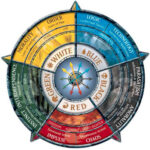Fashion is a dynamic reflection of cultural influences, traditions, and global interactions. As the world becomes increasingly interconnected, the fusion of cultural elements in fashion has become more prevalent and influential. This article explores how global traditions and trends converge in contemporary fashion, highlighting the impact of cultural exchanges on style, design, and consumer preferences.
#### **1. The Interplay of Global Traditions**
**1.1. Traditional Textiles and Techniques**
– **Japanese Kimono and Sashiko**: The Japanese kimono, with its intricate patterns and luxurious fabrics, has inspired numerous Western designers. Techniques like sashiko, a form of Japanese folk embroidery, are also being incorporated into modern fashion to add texture and artisanal craftsmanship.
– **African Wax Prints**: African wax prints, known for their vibrant colors and geometric patterns, have gained international popularity. Designers such as Stella Jean and Ozwald Boateng incorporate these prints into their collections, celebrating African heritage while making them accessible to a global audience.
**1.2. Cultural Symbols and Motifs**
– **Indian Sarees and Embroidery**: Traditional Indian garments like sarees and intricate embroidery techniques have been embraced by global designers. The use of rich fabrics like silk and intricate beading often appears in haute couture collections, reflecting the opulence and craftsmanship of Indian fashion.
– **Mexican Embroidery**: Mexican traditional embroidery, with its bright colors and detailed floral designs, has influenced global fashion, especially in the realm of bohemian and artisanal clothing. Designers are incorporating these elements into modern pieces, celebrating the cultural significance and aesthetic beauty.
#### **2. Global Fashion Trends and Cultural Cross-Pollination**
**2.1. The Rise of Global Influences**
– **Western-Asian Fusion**: The fusion of Western and Asian fashion has created a unique blend of styles. For instance, the incorporation of traditional Chinese elements like mandarin collars and intricate prints into contemporary Western designs reflects a merging of cultural aesthetics.
– **Ethnic Chic**: The trend of “ethnic chic” involves integrating traditional elements from various cultures into high fashion. This includes incorporating patterns, fabrics, and silhouettes from around the world into modern designs, creating a multicultural fashion narrative.
**2.2. Global Street Style**
– **Urban Fashion and Local Influences**: Urban fashion trends are often a melting pot of local styles from various cultures. Streetwear brands frequently draw inspiration from global cultures, resulting in diverse collections that reflect a blend of influences. For example, the integration of Japanese street style and African prints can be seen in contemporary streetwear collections.
– **Cross-Cultural Collaborations**: Collaborations between designers from different cultural backgrounds are becoming more common. These partnerships bring together diverse perspectives, leading to innovative and culturally rich fashion collections. For instance, the collaboration between Western brands and indigenous artisans often results in unique and respectful interpretations of traditional designs.
#### **3. The Impact of Globalization on Fashion**
**3.1. Increased Access to Diverse Influences**
– **Digital Platforms and Social Media**: The rise of digital platforms and social media has accelerated the exchange of fashion ideas across cultures. Influencers, designers, and fashion enthusiasts from around the world share and showcase diverse styles, making it easier for global fashion trends to influence and inspire each other.
– **International Fashion Weeks**: Major fashion weeks in cities like Paris, Milan, Tokyo, and New York showcase a global array of styles, often featuring designers who blend cultural traditions with contemporary fashion. These events highlight the convergence of global influences and set the stage for new trends.
**3.2. Challenges of Cultural Appropriation**
– **Respect vs. Exploitation**: While cultural exchange enriches fashion, there is a fine line between appreciation and appropriation. Ethical considerations arise when elements of one culture are used without proper understanding or respect for their significance. It is crucial for designers and brands to engage with cultural elements thoughtfully and respectfully.
– **Supporting Local Artisans**: A way to navigate these challenges is by collaborating with local artisans and communities. This approach ensures that cultural elements are represented authentically and that the communities contributing to the designs benefit from the fashion industry’s success.
#### **4. Navigating Cultural Influences in Your Wardrobe**
**4.1. Embrace Cultural Fusion**
– **Incorporate with Sensitivity**: When integrating cultural elements into your wardrobe, do so with sensitivity and respect. Choose pieces that honor the origin of the designs and avoid misrepresenting or trivializing cultural symbols.
– **Celebrate Diversity**: Use fashion as a way to celebrate and appreciate cultural diversity. Mix and match elements from different traditions to create a unique and personal style that reflects a global perspective.
**4.2. Support Ethical Brands**
– **Choose Brands with Integrity**: Support brands that engage in ethical practices and collaborate respectfully with cultural communities. Look for companies that provide fair compensation to artisans and honor the cultural significance of the designs they incorporate.
– **Educate Yourself**: Learn about the cultural backgrounds and significance of the fashion pieces you choose. Understanding the history and meaning behind designs enhances your appreciation and ensures you wear them with respect.
#### **5. Conclusion**
Cultural influences on fashion create a vibrant tapestry of global traditions and contemporary trends. The convergence of diverse cultural elements enriches fashion, offering new perspectives and innovative designs. As global fashion continues to evolve, it is essential to approach cultural elements with respect and thoughtfulness. By embracing cultural fusion, supporting ethical practices, and celebrating diversity, you can navigate the world of fashion in a way that honors both its global origins and its personal expression. Fashion is a powerful medium for cross-cultural exchange, and when done with integrity, it can bridge cultures and create a more inclusive and appreciative world of style.


